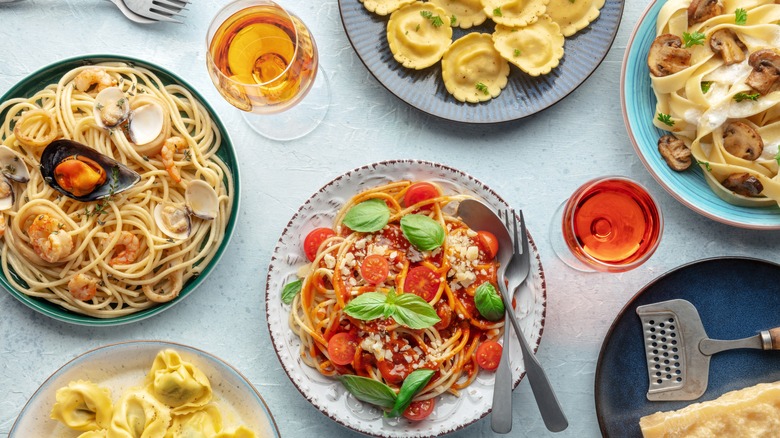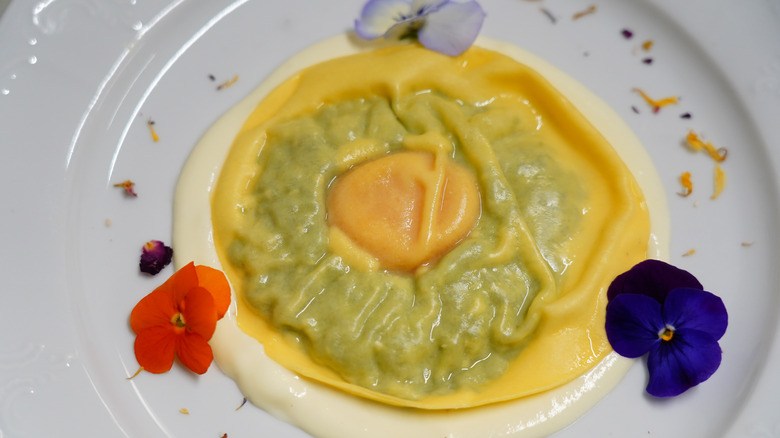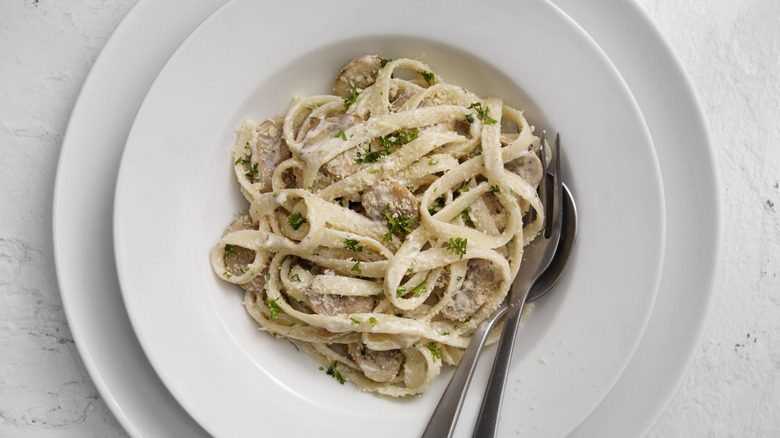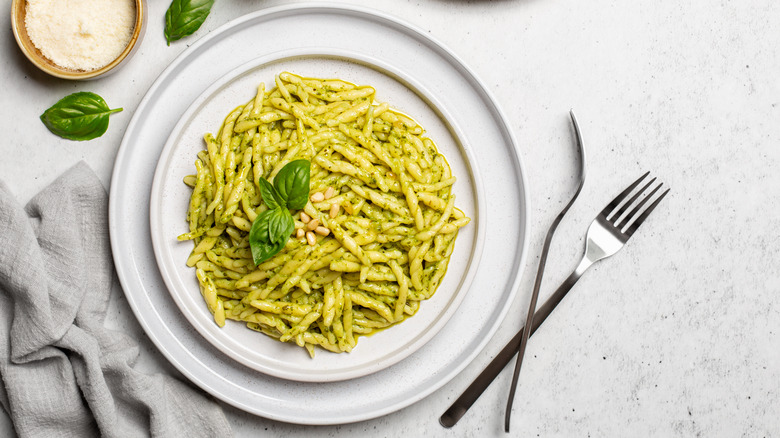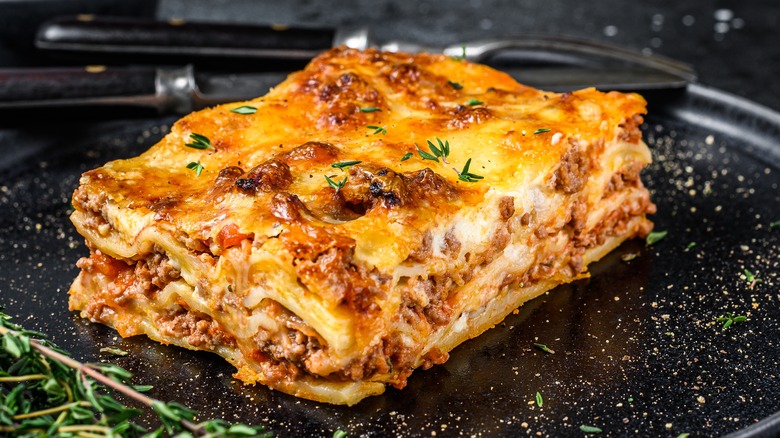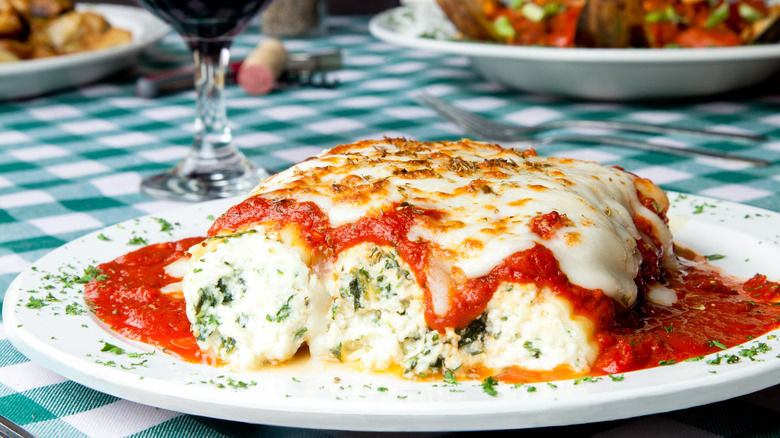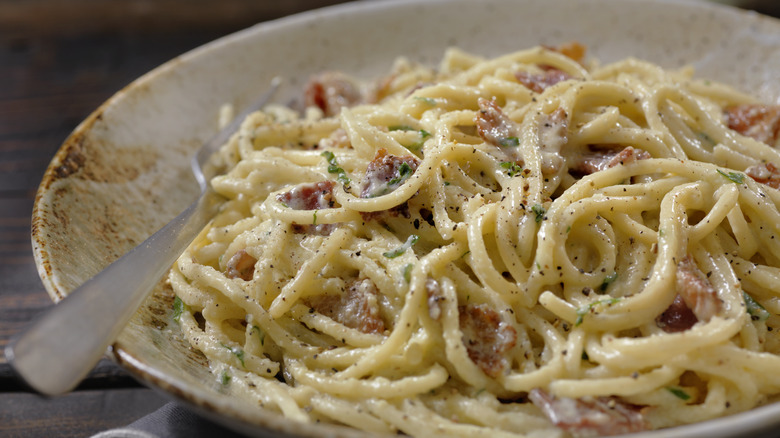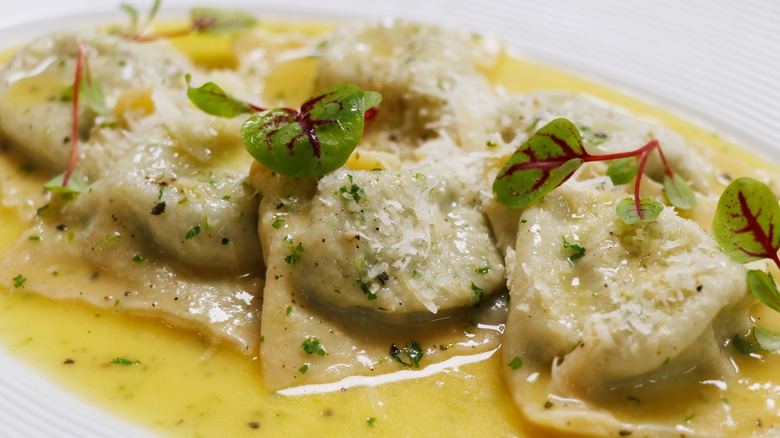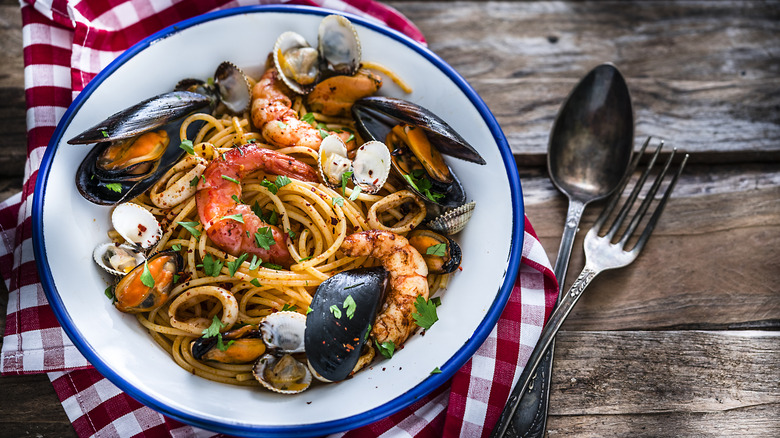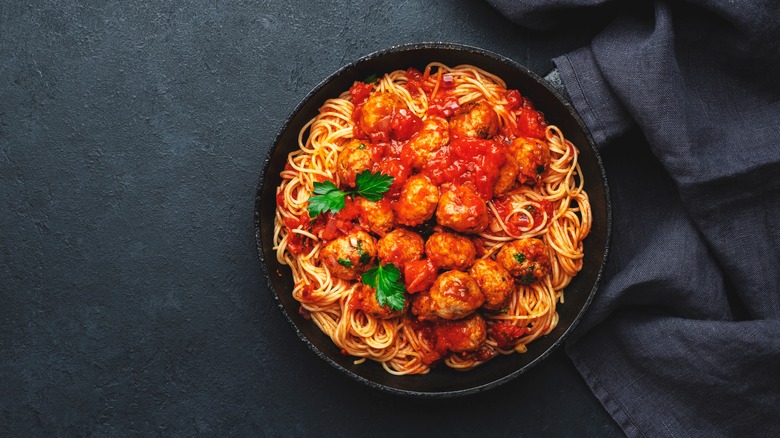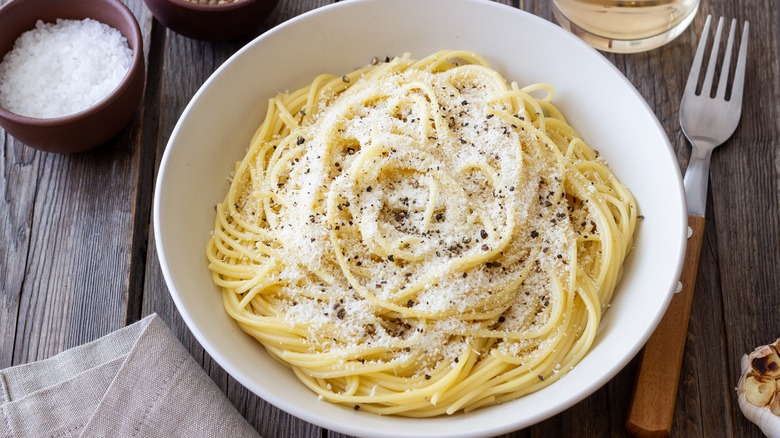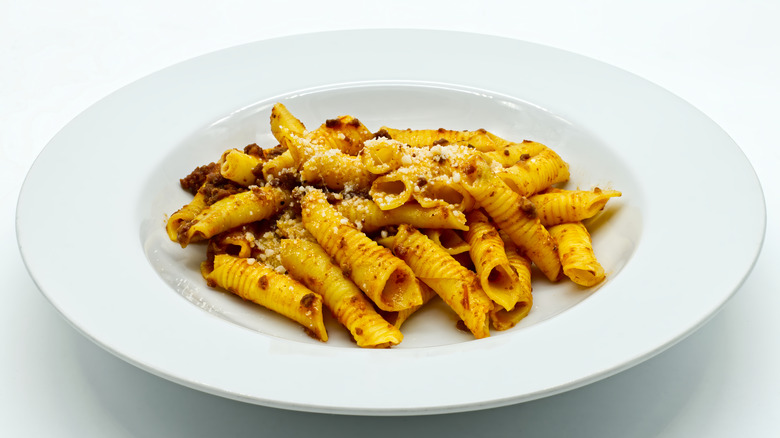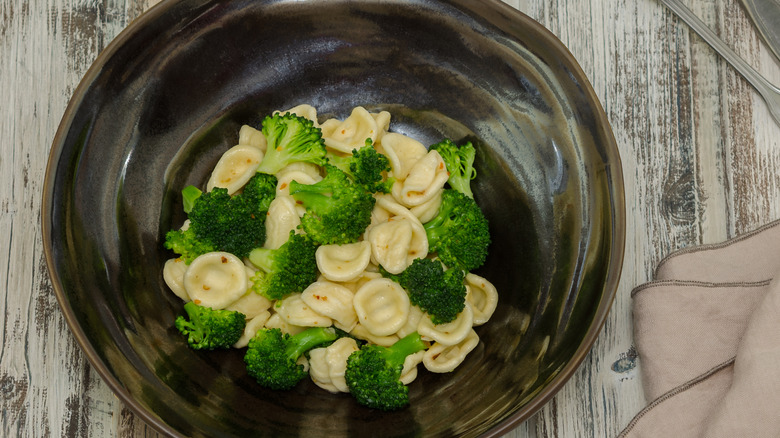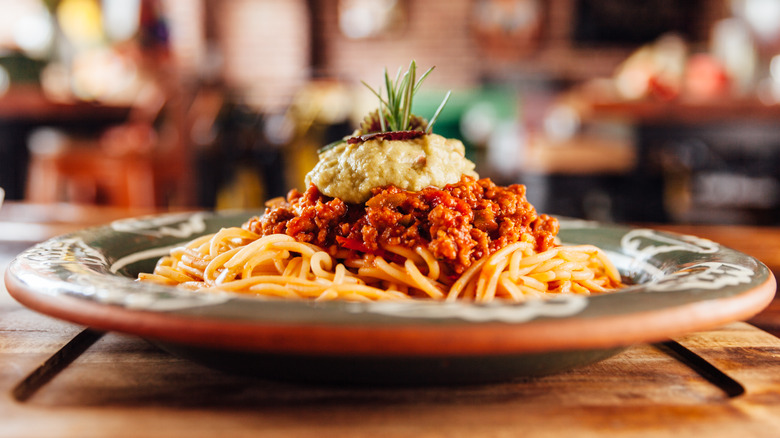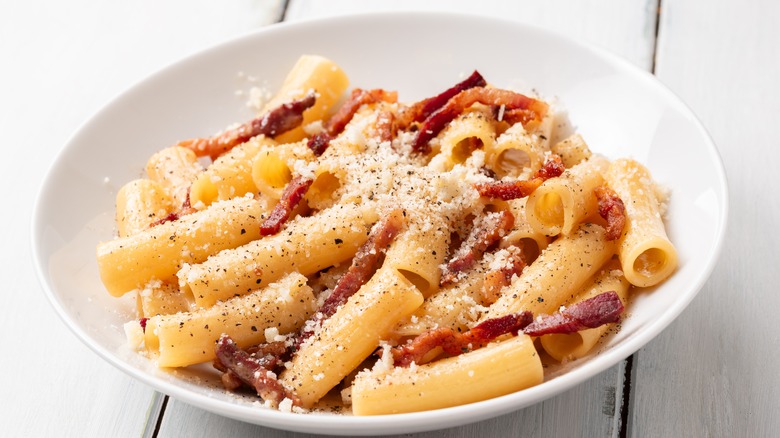Chefs Warn Us Not To Order These Dishes At Italian Restaurants & What To Order Instead
You're going to an Italian restaurant and you're excited to eat a big bowl of pasta. You order something you think sounds good — but what you read on the menu does not translate well on the plate. Thus, you are stuck with a disappointing pasta dish that you could have made better at home. And, worst of all, you're then slapped with the bill.
When you know what's good to order, though, you won't be in for a nasty surprise. That's why we spoke to three chefs and one food blogger to find out which pasta dishes to avoid at Italian restaurants and what to order instead. In some cases, going for familiar dishes — such as lasagna and fettuccine Alfredo — is a bad call. However, some classic dishes, like Bolognese, can be transcendent when done well. Eating out is also a good opportunity to try something new, and there are plenty of great pasta dishes they think are worth trying that you might never have heard of.
Armed with the opinions of our experts, we're about to get real about pasta dishes in Italian restaurants. We've got a list of six that are best avoided and eight you should probably order instead. All restaurants are different, of course, and the quality of the place you're eating makes a huge difference, too. But this is a solid starting point.
Good: Egg raviolo
Where's a good place to start when it comes to ordering the right sort of dish when you're eating out? Max Crask, executive chef at Italian restaurant Madrina in St. Louis, recommends egg raviolo. This is a type of stuffed pasta served as a single large raviolo (the singular word for ravioli) filled with runny egg yolk. Much like a poached egg, the yolk runs out when you cut into it. There are many mistakes you can make when poaching eggs, as many already know. It's no surprise, then, that it isn't easy to make egg raviolo. It probably isn't something you'll choose to cook at home — but you should keep a sharp eye out for it on restaurant menus.
"If this dish is on the menu I'm probably going to order it," says Crask. "I'm a sucker for runny egg yolk, and, if pulled off properly, there is something magical about that slightly thicker egg yolk oozing out and changing the flavor and texture of everything as you eat it," he adds. He also points out that if this dish is on the menu, it's usually a promising sign: "It takes some skill to pull this off in a professional kitchen, so it usually means I'm at a good restaurant."
Bad: Fettucine Alfredo
Fettuccini Alfredo — or any Alfredo pasta — is one best left for cooking at home. This classic pasta dish is popular for a reason. It's comforting, creamy, cheesy, and delicious when done right. It might not be hugely authentic (at least, not the way it's made in the U.S.), but the commonly found heavy cream version is an Italian-American classic. The trouble is, there are so many mistakes people can make with Alfredo sauce, that it's not worth risking in a restaurant.
"Every time I've seen a family member or a friend order a pasta alfredo dish, the pasta is swimming in a sea of white sauce," says Liz Krause of food blog Simple Italian Cooking. "Alfredo should technically cling to the pasta, not overpower it," she adds. She suggests that if you must have Alfredo, ask the chef to use half the amount of sauce when serving.
Max Crask agrees. "The reason I avoid it at all costs in an unfamiliar restaurant is because of the sauce," he says. According to Crask, some restaurants make the sauce in huge batches and this can occasionally lead to food safety issues. "Too many people that I know of, myself included, have been brutally poisoned by falling for its creamy pleasures," he remarks.
Good: Trofie al pesto
Trofie al pesto is a recommendation from Silvia Barban, chef at Brooklyn Italian restaurant and handmade pasta shop, LaRina Pastificio & Vino. She likes the simplicity of this dish, stating that it just contains basil, pine nuts, cheese, and a nice olive oil. "Good quality ingredients and it's a done deal," she remarks. She points out that parmigiano and pecorino are key here, creating that umami layer in the pesto.
It's easy to make errors with pesto, and you've probably had some subpar pesto dishes in your time. So, you might be wondering why you should trust trofie al pesto. Well, part of this is about the noodle choice. Trofie is a twisted pasta that comes from Northern Italy. It's kind of fashionable and on-trend in the food world right now. And, it's the perfect choice to go with pesto, as the sauce clings to it and sticks inside its twists. So, if a restaurant is using trofie and has chosen to pair it with pesto — its BFF — then it's a good sign. However, we wouldn't necessarily recommend ordering just any pesto dish, especially at a more basic Italian restaurant; you might end up disappointed.
Bad: Lasagna
Good lasagna can be great. "There is nothing better than a fresh slice of lasagna from a restaurant or just one somebody's mom made," says Max Crask. But, he notes that this isn't what you can expect from a typical Italian restaurant. "What you probably are going to get is a brick of rubber cheese that was made on a slow prep day a week or so ago, arriving at the table steaming hot on the outside while still cold in the middle, and drowned in sauce in an attempt to hide all the sins." Brutal but fair. Unless it's a place that's known for its lasagna, it's probably not going to be all that good.
Liz Krause also recommends avoiding restaurant lasagna. "Even though this is a classic Italian dish, many restaurants overload it with way too much cheese and sauce," she warns. She doesn't like that the noodles in many restaurant lasagnas aren't front and center, as they should be a key component of the dish. "If you can barely taste the noodles past the cheese and sauce, it's a real disappointment," Krause notes. So, for the most part, avoid the lasagna when eating at an Italian restaurant. It's rarely as good as homemade.
Good: Manicotti
Manicotti is among the pasta dishes you should always try at an Italian restaurant — if it's made right. "Manicotti is an amazing pasta recipe, and one of my favorites," says Liz Krause. But, what exactly is manicotti? It's a type of tube-like stuffed pasta that's often confused with cannelloni. Generally, it's stuffed with a combination of cheeses or ricotta cheese and another ingredient. However, the American version that you might have had at home or in a basic Italian restaurant is different from how good manicotti should be.
Krause suggests that you "only order this if they make the manicotti pasta from scratch." She explains that "the consistency is like a crepe, and is very different in taste and texture from store-bought manicotti tubes." So, before you go ahead and order manicotti, ask about how it's made. If produced the authentic Italian way with crepes or crepe-like fresh pasta, you could be in for a real treat. However, restaurant versions made using store-bought manicotti tubes are best avoided.
Bad: Carbonara
Silvia Barban has strong opinions on carbonara. "I never trust anyone with a carbonara in the States," she remarks. "I've seen parsley, I've seen bacon or cream" — these are all absolute no-gos for an authentic carbonara, which is why Barban recommends avoiding any you see on an average Italian restaurant menu.
Nobody should be adding cream to carbonara, that's for sure. Yet, it's a common misconception that it should be a cream-based dish. That's why it can go so wrong on an Italian restaurant menu. "Carbonara is only made with pecorino, egg yolk, guanciale, and black pepper," says Barban, setting the record straight. It can be excellent if it's done right. But, it's rarely made correctly this side of the Atlantic. That's why she recommends that you "always make sure to read the ingredients before [you] order."
Good: Spinach and ricotta ravioli
Ravioli is popular for a reason — it's delicious. Especially when made skillfully by a good restaurant. After all, it's the kind of thing that few people go to the effort of making from scratch at home. Of course, it's perfectly possible to do so, but it takes time, equipment, and a lot of practice to get it right. Silvia Barban recommends "spinach and ricotta ravioli in a brown butter sauce." She says it's "a classic dish where the filling of the pasta is the star of the show with ricotta, Parmigiano, and spinach."
Just those few basic ingredients — along with fresh pasta made from flour, egg, and water — come together to make something special. Simplicity is often at the heart of Italian food. With the filling being somewhat understated, you don't want an overpowering sauce, which is where brown butter comes into play. It's made by cooking butter until the milk solids separate out and start to brown, giving it a complex, nutty flavor — which is why you can't go wrong using brown butter in your recipes, and why it's a great addition to pasta dishes.
Bad: Seafood specials
If you notice a seafood special on the menu, you should run for the hills, if Max Crask has any say in the matter. According to Crask, it's often a sign that the dish won't be fresh. "When I see tutto mare as a Tuesday special then you can assume it's the chef selling you fish that doesn't smell that bad yet," he says.
The logic behind this is that restaurant specials are often created to use up ingredients that the kitchen has too much of and that might otherwise spoil. While the seafood used in a special shouldn't be totally past its best, it's likely that it's nearing the end of its usable life, and it won't be as tasty as seafood that's actually fresh. Fortunately, his only applies to specials. "If it's a dish on the menu, then I say to go for it," Crask remarks.
Good: Spaghetti and meatballs
You might think that spaghetti and meatballs is a dish that's too simple and everyday to order at an Italian restaurant. But, in fact, that's the beauty of it. "It's rare to find a good spaghetti dish, especially because you can get burned a lot and are scared to order it, but if done really well, it can tie your adult pallet with what you grew up eating," says Max Crask.
"Take away the hammered and soggy pasta, the store-bought gray meatballs, and the canned sauce that tastes like the thousand-year-old 'Italian seasoning' that has been in the spice rack your whole life, and there can be something exceptional there," Crask notes. "But only if done properly," he adds. So, if somewhere is known for their great spaghetti and meatballs, this is a chef-approved dish to try. Or, even if you haven't heard about the spaghetti and meatballs specifically, but you're eating at a high-quality Italian restaurant, it's fairly safe to assume they're good. It's the kind of dish that a great chef wouldn't put on the menu unless they knew they did it well.
Bad: Cacio e pepe
Cacio e pepe is having a moment right now. It's basically a simplified Italian version of mac and cheese. It seems like restaurants couldn't go too far wrong with it, yet it's one dish that Silvia Barban recommends avoiding at an Italian restaurant. Not because it's a bad dish, but because a lot of chefs get it wrong.
"Not a lot of places know how to make it in the right way," Barban notes. She goes on to say that "so many places use butter" when "the real cacio e pepe is only black pepper and great quality pecorino romano cheese." Some pasta water is added to the mix, and that cheese and pepper turns into a rich, creamy sauce that's worth writing home about.
It seems like this would be easy to pull off but chef Tiffany Derry of Radici agrees that it often isn't done right. "One of the most ordered dishes in an Italian restaurant is cacio e pepe and, while it is one of my favorites, it is often not executed properly so I tend to avoid ordering it," she remarks.
Good: Garganelli
While it's a type of pasta rather than a pasta dish, Liz Krause recommends trying garganelli if you see it on the menu. "This is a type of pasta that I'm seeing more often, it's similar to penne but it is hand rolled," she says. It looks similar to penne tubes, but you can see the point where each piece is joined by hand. There are also horizontal ridges around it, which can help hold onto the sauce. Garganelli isn't widely available commercially. So, when you see it on a menu, the likelihood is that it's handmade by the chefs, making it worth trying.
Krause notes that this type of pasta is "often served with a mushroom sauce." However, you may find it with a range of sauces and accompaniments on a menu, so if you like the sound of the sauce, you should give it a whirl. There are so many types and shapes of pasta and many of us always stick to the old favorites. "My advice is to try new pastas and experience the joy of trying something different," suggests Krause. "If not garganelli, try another pasta you have not had before." You might just find a new favorite.
Bad: Pasta con broccoli
Another dish that Max Crask recommends avoiding is pasta con broccoli. It can be made in a range of ways. Simple versions contain just good-quality olive oil, grated hard cheese, such as pecorino or parmesan, garlic, and broccoli, tossed with noodles. Richer versions may contain heavy cream or a béchamel sauce. And, you might even find some tomato variations.
Crask concedes that it can be tasty, but it isn't a reliable option. "I grew up in St. Louis and these dishes are staples on any Italian restaurant's menu here," he says. "Honestly, it's the food I grew up with and I love it. It's a guilty pleasure that most people look at as fake Italian food." So, maybe it's fine if you're looking for something comforting and nostalgic. But, anyone who wants an authentic Italian dish should look elsewhere. Crask also gives the same warning he did with fettuccine Alfredo — the sauce is sometimes made in bulk and reheated, which might lead to food poisoning.
Good: Bolognese
"A proper Bolognese takes time to make, so why not pay someone else to make it for you?" Liz Krause asks. And we totally agree with that logic. Bolognese might seem like a pretty middle-of-the-road dish, but when it's cooked well, it can be incredible. And, if a good Italian restaurant has it on the menu, you can assume it's going to be a high-end version that's slow cooked and delicious.
Tiffany Derry agrees that Bolognese is a good dish to order, noting that the proper Italian version is so much different from what most people grew up eating in America. "Traditional Bolognese must cook for a minimum of 4 hours, does not usually have a lot of tomato in the sauce, and the meat should be tender," she explains. "There are many different home styles and regions that create a Bolognese dish in a slightly different way," Derry adds. So, depending on the chef at the restaurant, you might end up with one of countless variations. It's the kind of dish that's rarely the same from two different cooks.
Good: Pasta alla gricia
Pasta alla gricia is a classic dish from Rome. It's sometimes described as a carbonara without the eggs — but it hasn't reached the same heights of popularity as carbonara. It's made by frying guanciale, adding pasta water to make an emulsion with the pork fat, and adding pecorino romano and plenty of black pepper — simple but delicious.
Tiffany Derry suggests a very specific variation on this dish — coniglio alla gricia. Tiffany's version is made with a curled pasta shape called cassarece and "mixed with braised rabbit, guanciale, pecorino romano, bitter greens and black pepper." However, any pasta alla gricia is worth trying.
Derry recommends choosing pasta dishes inspired by classics. "When dining out, I tend to order something traditional because it really shows the depth of the knowledge of the chef," she says. "Just because it is a classic dish, doesn't mean it is easy to execute. There's a reason these traditional pasta dishes have been passed down for so long," she adds. Even though it might seem like a simple dish, pasta alla gricia is a delicious menu choice. And there's a big gap between a version that's perfectly executed and one that's cobbled together at home.
